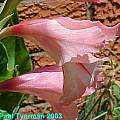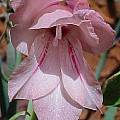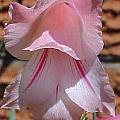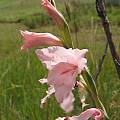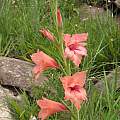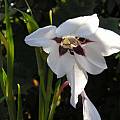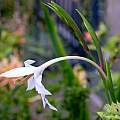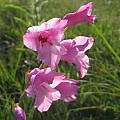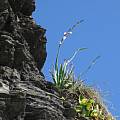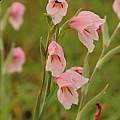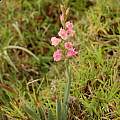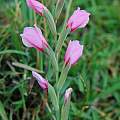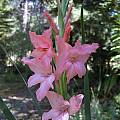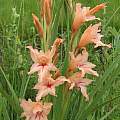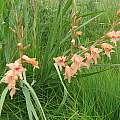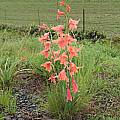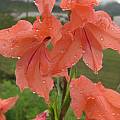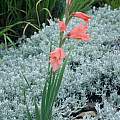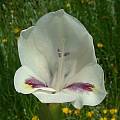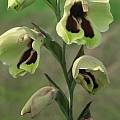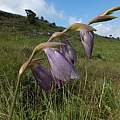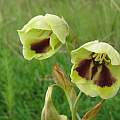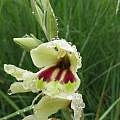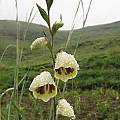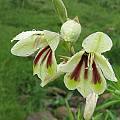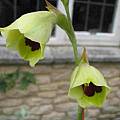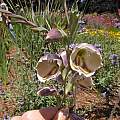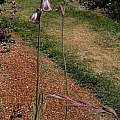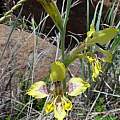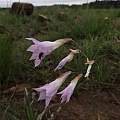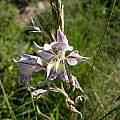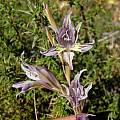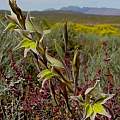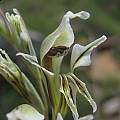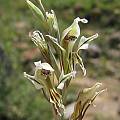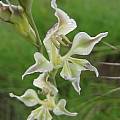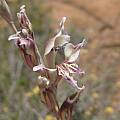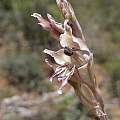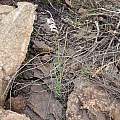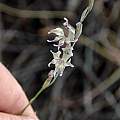Summer rain Gladiolus are mostly from the eastern part of South Africa. They generally like their summers wet and their winters dry, but just exactly how wet and how dry may vary widely depending on on the exact location of origin. Among the summer rain species are some of the most frost hardy of the African species, but as most tropical African Gladiolus follow a summer rain pattern as well, some are quite frost tender.
Page 1: G. albens... Page 2: G. densiflorus... Page 3: G. inandensis... Page 5: G. rehmannii... Page 6: G. sericeovillosus...
Gladiolus mortonius (formerly Gladiolus ochroleucus var. macowanii) is a summer rainfall Eastern Cape species that grows in open stony grassland. Although it resembles Gladiolus ochroleucus, the long tubed pink flowers with a red median streak on the lower tepals and a few reddish longitudinal lines parallel are much larger (tube is 30-45 mm). It is a gorgeous little gladiolus that grows successfully in a pot, producing flower stems around 8-9 inches tall, with comparatively large flowers that face slightly downwards. The photo (face) is taken upwards into the flower to show detail. This has had a succession of flowers since late February (in Australia) and is now sending up another spike in mid April just as the last of the previous flowers have faded. The first three photos by Paul Tyerman.
The photos below were taken in the Eastern Cape by Cameron McMaster February 2008. The first was taken at Andriesberg and the last two at Cathcart.
Gladiolus murielae syn. Acidanthera bicolor , Gladiolus callianthus , and Acidanthera murielae is a species with a wide distribution from northeastern Africa southward to Mozambique. It is often sold or described under the Acidanthera synonyms or, as it is most common in northern Ethiopia, sometimes called Abyssinian gladiolus. This species has long tubed white flowers with dark purple markings in the midline on the lower tepals or all tepals and is fragrant, more strongly at night. Since it comes from a tropical climate, it is often protected in colder climates and dug in the winter and stored and replanted after the last frost so that it will be summer growing, blooming late summer into fall. Photo 1 by Arnold Trachtenberg of plants blooming in the Brooklyn Botanical Garden, Photo 2 by Martin Bohnet illustrates the length of the tube.
Gladiolus ochroleucus grows in grasslands and light bush or woodland in the Eastern Cape. Flowers are either shades of pink, sometimes light purple or reddish, or whitish or yellow flushed brownish on the reverse. The lower tepals are white in the lower half sometimes with dark red-purple median streaks. The first two photos by Cameron McMaster were taken January 2008 in the Eastern Cape. Photos number three, four, and five were taken near Morgan Bay by Bob Rutemoeller and Mary Sue Ittner.
Gladiolus oppositiflorus Herb. is found in the southern part of the summer rainfall area where it grows in open grasslands and often in rocky sites where there is some protection from predators. Flowers are salmon to pale pink or mauve, with the lower three tepals paler in the midline and having a reddish to purple median streak. This species blooms summer into fall. The first two photos by Mary Sue Ittner of a plant growing in the ground in Northern California and blooming late August-September 2004. The last two photos were taken by Cameron McMaster at Maclear in the Eastern Cape February 2008.
A shorter-stemmed form with salmon colored flowers was described as Gladiolus salmoneus Baker and later considered to be Gladiolus oppositiflorus ssp. salmoneus (Baker) Oberm. Although this subspecies is still recognized by Kew, Goldblatt and Manning in Gladiolus of Southern Africa did not think the differences warranted subspecies treatment. The first two photos of this form taken in the Eastern Cape January 2008 by Cameron McMaster. The last photo is from Rachel Saunders.
Gladiolus papilio Hook.f. (syn. G. purpureo-auratus, G. brachyscyphus, G. spathulatus, G. schlechteri) is called the Butterfly Gladiolus, and grows in marshy ground, up to 2400 m, from the Eastern Cape to Limpopo Province. It is claimed to be a hardy garden plant, grown in the UK since 1866. The first two photos were taken by Roy Herold in KwaZulu-Natal Province, near Kamberg in the foothills of the Drakensberg, in early December 2006. The third was taken by Rod Saunders. The fourth, an unusual color form, was taken by Rachel Saunders in the mountains above Tzaneen, early January 2015.
The photos below were taken by Cameron McMaster in Lesotho.
The first photo from John Grimshaw is of a form he labels in the "purpureoauratus" group. The second and third photos were taken by Bob Rutemoeller in the Mendocino Coast Botanical Gardens.
Gladiolus pardalinus Goldblatt & J.C.Manning is restricted to the bushveld of Northern Province and Mpumalanga, South Africa where it grows in dolerite in rocky ground. Growing from 35 to 55 cm high, it has usually three leaves that sheath and envelope the stem and 10 to 15 flowers in a spike. Flowers are pale yellow speckled with red brown markings on all except the dorsal tepal. All of the tepals are clawed at the base. This species flowers in early spring, mid October and November. Photo from Rachel Saunders.
Gladiolus parvulus Schltr. is restricted to the southern half of KwaZulu-Natal, South Africa, into Lesotho where it grows in thin soil on sandstone pavements or in cracks in sandstone outcrops at elevations up to 3300 m. Growing from 15 to 35 cm, it has two leaves, the larger sheathing the stem and the second a small bract-like leaf immediately below the lowest flower. It has small horizontal to almost nodding light pink flowers with equal tepals. The flowers have been described as looking more like an Ixia or a Dierama. It flowers October to early December. Photo from Rachel Saunders.
Gladiolus permeabilis D.Delaroche grows on shale slopes in renosterveld from Caledon east through southern Africa and to Zimbabwe. In the Cape province it blooms late winter into spring. Usually 20 to 30 cm tall, but can be up to 50 cm, it has flat narrow leaves with a prominent midrib and mauve to dull purple or cream flowers with yellowish makings. Flowers are usually intensely fragrant. The first photo was taken by Cameron McMaster in the Overberg and the second by Bob Rutemoeller in the Bontebok National Park. The last photo below from the book Plants of the Klein Karoo courtesy of Jan and Anne Lise Schutte-Vlok
Gladiolus permeabilis ssp. edulis (Burch. ex Ker Gawl.) Oberm., syn. Gladiolus edulis, is widespread across the summer-rainfall zone and is common in the drier areas. This subspecies has whitish to cream, sometimes grey or mauve flowers. All of the tepals except for the dorsal have a grey to purple or maroon midline sometimes surrounded by a yellow streak. The lower lateral tepals are yellow in the upper half. Tepals have an elongated and tapering tip or tail-like twisted and undulate appendages. Photos taken by Cameron McMaster in two locations in the Eastern Cape.
The photos below were taken at Andriesberg by Cameron McMaster and Bob Rutemoeller in January and February, different years.
Page 1: G. albens... Page 2: G. densiflorus... Page 3: G. inandensis... Page 5: G. rehmannii... Page 6: G. sericeovillosus...
